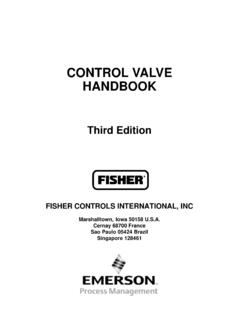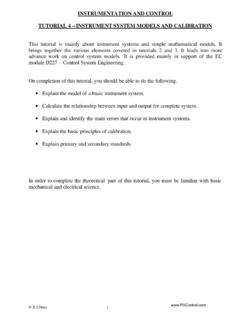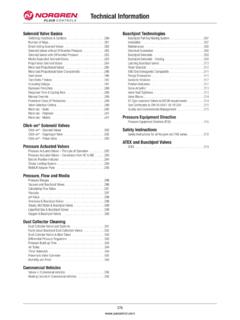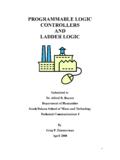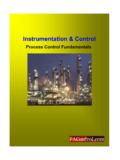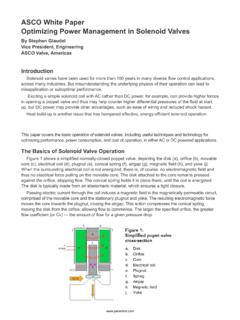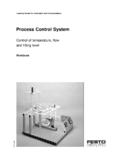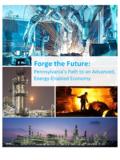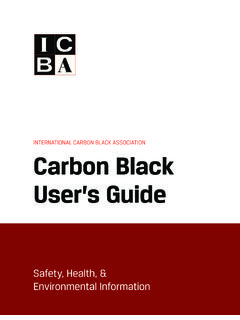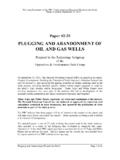Transcription of Oil and gas production handbook - pacontrol.com
1 0 OIL AND GAS production handbook An introduction to oil and gas production H vard Devold 2006 ABB ATPA Oil and Gas 1 PREFACE This handbook is has been compiled to give readers with an interested in the oil and gas production industry an overview of the main processes and equipment. When I started to search for a suitable introduction to be used for new engineers, I discovered that much of this equipment is described in standards, equipment manuals and project documentation. But little material was found to quickly give the reader an overview of the entire upstream area, while still preserving enough detail to let the engineer get an appreciation of the main characteristics and design issues., This book is by no means a comprehensive description on the detailed design of any part of this process, and many details have been omitted in the interest of overview .
2 I have included some comments on the control issues, since that is part of my own background. For the same reason, the description will be somewhat biased toward the offshore installations. The material has been compiled form various online sources as well as ABB and customer documents. I am thankful to my colleagues in the industry for providing valuable input, in particular Erik Solbu of Norsk Hydro for the Njord process and valuable comments. I have included many photos to give the reader an impression what typical facilities or equipment look like. Non-ABB photo source given below picture other pictures and illustrations are ABB. Edition Oslo, June 2006 H vard Devold 2006 ABB ATPA Oil and Gas Except as otherwise indicated, all materials, including but not limited to design, text, graphics, other files, and the selection and arrangement thereof, are the copyright property of ABB, ALL RIGHTS RESERVED.
3 You may electronically copy and print hard-copy of this document only for non-commercial personal use, or non-commercial use within the organization that employs you, provided that the materials are not modified and all copyright or proprietary notices are retained. Use of photos and graphics and references form other sources in no way promotes or endorses these products and services and is for illustration only. 2 CONTENTS 1 4 2 Process overview .. 6 Facilities .. 7 8 Offshore .. 9 Main Process 12 Wellheads .. 12 12 Separation .. 13 Gas compression .. 14 Metering, storage and export .. 15 Utility 16 3 Reservoir and Wellheads .. 17 Crude oil and Natural gas .. 17 Crude Oil .. 17 Natural Gas .. 18 Condensates.
4 19 The Reservoir .. 19 Exploration and 21 The 24 Well Casing .. 25 Completion .. 26 Wellhead .. 27 Subsea wells .. 29 Injection .. 30 Artificial Lift .. 30 Rod 31 Downhole 31 Gas Lift .. 32 Plunger Lift .. 33 Well workover, intervention and stimulation.. 33 Unconventional sources of oil and gas .. 35 Extra Heavy Crude .. 35 Tar 36 Oil Shale .. 36 Coal, Coal Gasification and 37 Methane Hydrates .. 37 38 Hydrogen .. 38 4 The Oil and Gas Process .. 40 Manifolds and 42 3 Pipelines, and Risers .. 42 production , test and injection 42 43 Test Separators and Well 43 production 43 Second stage 45 Third stage 45 Coalescer .. 46 Electrostatic Desalter .. 46 Water treatment.
5 46 Gas treatment and 48 Heat 48 Scrubbers and 49 Compressor anti surge and 50 Gas 54 Oil and Gas Storage, Metering and Export .. 54 Fiscal Metering .. 54 Storage .. 57 Marine Loading .. 58 Pipeline terminal .. 58 5 Utility systems .. 59 Control and Safety Systems .. 59 Process Control .. 59 Emergency Shutdown and Process Shutdown .. 62 Control and Safety 63 Fire and Gas 65 Telemetry / SCADA .. 66 Condition Monitoring and Maintenance Support .. 67 production Information Management Systems (PIMS) .. 68 Training Simulators .. 69 Power generation and 69 Flare and Atmospheric Ventilation .. 71 Instrument air .. 72 HVAC .. 72 Water 73 Potable 73 73 Ballast Water .. 73 Chemicals and 74 77 6 78 7 80 8 82 4 1 Introduction Oil has been used for lighting purposes for many thousand years.
6 In areas where oil is found in shallow reservoirs, seeps of crude oil or gas may naturally develop, and some oil could simply be collected from seepage or tar ponds. Historically, we know of tales of eternal fires where oil and gas seeps would ignite and burn. One example 1000 is the site where the famous oracle of Delphi would be built, and 500 Chinese were using natural gas to boil water. But it was not until 1859 that "Colonel" Edwin Drake drilled the first successful oil well, for the sole purpose of finding oil. The Drake Well was located in the middle of quiet farm country in north-western Pennsylvania, and began the international search for and industrial use of petroleum. Photo: Drake Well Museum Collection, Titusville, PA These wells were shallow by modern standards, often less than 50 meters, but could give quite large production .
7 In the picture from the Tarr Farm, Oil Creek Valley, the Phillips well on the right was flowing initially at 4000 barrels per day in October 1861, and the Woodford well on the left came in at 1500 barrels per day in July, 5 1862. The oil was collected in the wooden tank in the foreground. Note the many different sized barrels in the background. At this time, barrel size was not yet standardized, which made terms like "Oil is selling at $5 per barrel" very confusing (today a barrel is 159 liters, see units at the back). But even in those days, overproduction was an issue to be avoided. When the Empire well was completed in September 1861, it gave 3,000 barrels per day, flooding the market, and the price of oil plummeted to 10 cents a barrel. Soon, oil had replaced most other fuels for mobile use.
8 The automobile industry developed at the end of the 19th century, and quickly adopted the fuel. Gasoline engines were essential for designing successful aircraft. Ships driven by oil could move up to twice as fast as their coal fired counterparts, a vital military advantage. Gas was burned off or left in the ground. Despite attempts at gas transportation as far back as 1821, it was not until after the World War II that welding techniques, pipe rolling, and metallurgical advances allowed for the construction of reliable long distance pipelines, resulting in a natural gas industry boom. At the same time the petrochemical industry with its new plastic materials quickly increased production . Even now gas production is gaining market share as LNG provides an economical way of transporting the gas from even the remotest sites.
9 With oil prices of 50 dollars per barrel or more, even more difficult to access sources become economically interesting. Such sources include tar sands in Venezuela and Canada as well as oil shales. Synthetic diesel (syndiesel) from natural gas and biological sources (biodiesel, ethanol) have also become commercially viable. These sources may eventually more than triple the potential reserves of hydrocabon fuels. 6 2 Process overview The following figure gives a simplified overview of the typical oil and gas production process ProductionWellheadsProductionand TestManifolds Test SeparatorProduction Separators1 stage2 stageW ater treatmentGas compressorsLPHPM etering andstoragePigLauncherGasMeterOilMeterGas PipelineOil StorageCrudepumpPigLauncherOilPipelineTa nkerLoadingInjectionwellsInjectionmanifo ldW ater injectionpumpGas injectioncompressorUtility systems (selected)
10 Power GenerationInstrument AirPotable WaterFirefightingsystemsHVACE xportDrillingMud and Cementing Figure 1 Oil and Gas production overview 7 Today oil and gas is produced in almost every part of the world, from small 100 barrel a day small private wells, to large bore 4000 barrel a day wells; In shallow 20 meters deep reservoirs to 3000 meter deep wells in more than 2000 meters water depth; In dollar onshore wells to 10 billion dollar offshore developments. Despite this range many parts of the process is quite similar in principle. At the left side, we find the wellheads. They feed into production and test manifolds. In a distributed production system this would be called the gathering system. The remainder of the figure is the actual process, often called the Gas Oil Separation Plant (GOSP).
